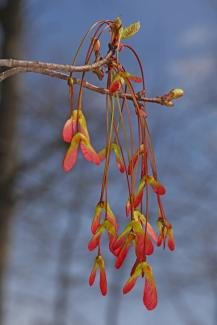
According to Plant NoVA Natives https://www.plantnovanatives.org/, this is a good choice for public spaces because it tolerates compacted soils, air pollution, wet and a variety of soils but not alkaline. Medium to fast growing. Tolerates light or moderate shade.
Habitat: swamps, uplands; occasionally on dry rocky hillsides and sanddunes
Wildlife Value: Bees are attracted to the early nectar source of the flowers. Members of the genus Acer support Imperial Moth (Eacles imperialis) larvae. Flower nectar attracts bees and other pollinators. Seeds are enjoyed by birds. The fruit, along with the buds, are a primary food source for gray squirrels in late winter and early spring. Sprouts are a favorite food for white-tailed deer, but this tree is moderately resistant to damage. Plant NOVA Natives lists this species as particularly popular with the non-native honeybees
Notes: Early spring bloomer; one of the earliest food sources for pollinators; adaptable. This tree is included in the Homegrown National Park: Keystone Trees and Shrubs.
Earth Sangha Inventory
Founded in 1997, the Earth Sangha is a nonprofit public charity based in the Washington, DC, region. The Wild Plant Nursery is the most comprehensive source of local-ecotype, native plants in the Washington DC region, and the region’s only facility dedicated exclusively to this type of propagation. “Local-ecotype” plants are propagated from local, wild, naturally-occurring populations and are well-adapted to local conditions and for wildlife species that depend on the local forms, such as pollinators. Inventory is updated on a weekly basis so number may not be accurate.
| Pots Available | Plugs Available | Location | Notes | ||
|---|---|---|---|---|---|
| 51 | 0 | Row 18 | View My Wishlist |
Carniola Farms Nursery
Nursery operates Arlington Native Plants & Edibles located at 925 N. Madison St. Arlington Virginia 22205. Plants can be purchased at any time by making an email appointment at carniolafarms@gmail.com. Also, during the during the planting season, they are open some Saturdays from 11AM to 3PM. Check their website for datesThis plant list is from the beginning of the 2025 season and may be out-of-date
| In Stock? | Notes | ||
|---|---|---|---|
| Yes | View My Wishlist |
Beloved Brook's Ruckersville Nursery Inventory
Nursery is open by appointment only. Email them to set up a time. This plant list if from the begging of the 2025 season and may be outdated. If there is something specific that you’re looking for, they recommend you confirm that they have it when you schedule an appointment
| Pots Available | Plugs Available | Pot size: | ||
|---|---|---|---|---|
| Yes |
Gallon |
View My Wishlist |

